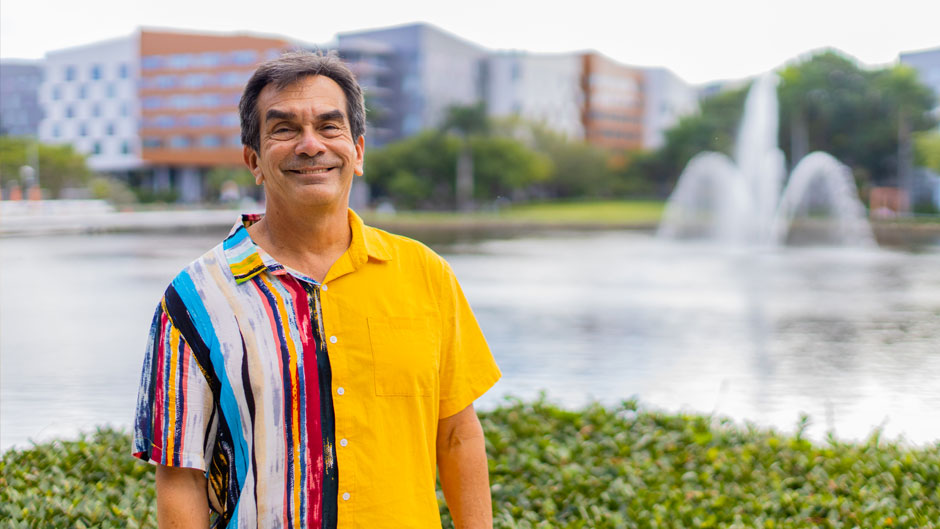The world’s “last best hope” of saving the planet from the most severe effects of climate change gets underway on Oct. 31 when some 20,000 delegates representing 197 nations will gather in Glasgow, Scotland, for the COP26 global climate summit.
One of them will be Daniel Suman, a professor of environmental science and policy at the University of Miami Rosenstiel School of Marine and Atmospheric Science, who will be representing his home country of Panama.
“Dramatic flooding events, raging wildfires, more powerful storms, excessive heat waves and drought—the impacts of global climate change are certainly being felt more and more all over the world,” Suman said. At the same time, he pointed out, global carbon dioxide levels in the atmosphere hit a record high last year, indicating that some countries have fallen far short in their pledges to cut greenhouse gas emissions.
And in many respects, that is why the goals of the upcoming two-week summit—formally, the 26th UN Climate Change Conference of the Parties—couldn’t be more urgent, he said. During the conference, which U.S. climate envoy John Kerry has called the “last best hope for the world to get its act together,” government officials will try to accelerate action toward the Paris Agreement’s objective of limiting global warming to 1.5 degrees Celsius above preindustrial levels.
Suman said the importance of mangroves shouldn’t be overlooked in helping the planet to reach that goal.
“We’ve known for years that they are crucial nursery grounds for many species of fish that are commercially valuable, especially shrimp,” said Suman, who has studied the ecosystem benefits of mangroves, including their importance in climate change mitigation and adaptation, for the past three decades. “They provide food for local communities. They are important sites for biodiversity and migratory birds. And they provide products for local communities like wood and honey.”
But where they really pack a punch in the fight against climate change is in their ability to sequester and trap carbon. “Mangrove biomass and particularly mangrove organic-rich sediments are extremely important sinks for carbon,” explained Suman, noting that these coastal systems trap carbon at a much faster rate than terrestrial forests. Some research, he noted, has shown that one hectare of mangroves, about the equivalent of two and a half acres, can hold as much as 328 tons of carbon.
But in some parts of the world, mangroves are in peril, their numbers dwindling because of encroaching urban and port development as well as agricultural expansion projects. And that is why it is vital that mangroves be protected, Suman said.
In many tropical and subtropical countries around the world, laws and regulations are already in place to protect mangroves, making it illegal to cut, remove, or damage them. But such laws can often be difficult to enforce, according to Suman.
“In order to see what’s happening with mangroves, you need to have people in boats patrolling in the field,” explained Suman, who holds an adjunct appointment at the School of Law. “Yet, mangroves are relatively difficult areas to access. They’re isolated, and many people do not realize their importance. So, enforcement can be a big problem.”
Suman has been involved in education, mangrove management, and legislation efforts for more than 30 years, mostly in Central America, Cuba, and Mexico.
In the early 1990s, when he first arrived at the University, he organized and led a series of meetings in Miami, Nicaragua, and Panama for ecosystem managers from throughout the Caribbean and Central and South America, taking field trips to mangrove areas, conducting training exercises, and addressing and proposing ways to improve laws aimed at protecting mangroves.
Today, he is also an instructor for the Ramsar Regional Centre for Training and Research on Wetlands in the Western Hemisphere in Panama, teaching about six different courses a year on mangrove management.
Mangrove restoration projects can be lifesavers for these important ecosystems, Suman said. “Newly planted mangroves will absorb greenhouse gases,” he added. “So, there are opportunities for countries in the global south and developing countries like Panama to receive funding for afforestation projects through the voluntary carbon market as well as for their efforts to protect existing mangrove forests.”
As a member of the Panamanian delegation at COP26, Suman will participate in a panel discussion on mangroves, promoting them as invaluable blue carbon sinks.
“I feel quite lucky and honored to be able to attend the conference,” he said. “I’m happy to support Panama’s efforts in addressing the global climate emergency and seeing how the process actually works will be an experience I can bring back to my students at the University of Miami.”

